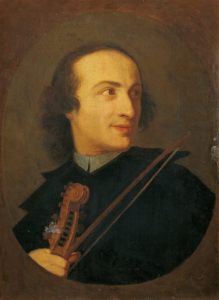Tartini, Devil’s Trill Sonata
Giuseppe Tartini (1692-1770) is best known for his Sonata No. in G minor (GT 2.g05), known informally as the “Devil’s Trill” sonata. The trill in question occurs in the final movement (at 9:44-10:00 in this recording) in which Tartini demands double-stop trills.
A double stop on a stringed instrument refers to bowing two strings at the same time. One can also find examples of triple and quadruple stops. Because instruments in the violin family have a curved bridge, the bow can easily contact two strings simultaneously, but triple and quadruple stops are usually accomplished with a broken or arpeggiated chord.
Double stops are common in the string repertoire, but performing a trill on one of the notes adds a new layer of difficulty. Since I’m not a string player, I won’t try to assess how difficult this particular passage might be. Like many techniques in music, it obviously was received initially as devilishly difficult only later to become something serious instrumentalist were expected to master routinely.
Tartini was born in Pirano on the Istria peninsula, now part of Slovenia, and spent the better part of his life in Padua. Like so many other composers, he initially studied law before devoting his professional life to music. His compositional output consists almost entirely of violin sonatas and concertos.
He recounted that he had written the Devil’s Trill sonata after awaking from a dream in which he heard the Devil playing violin at the foot of his bed. Violin seems to be the Devil’s instrument of choice if you factor in stories like A Soldier’s Tale or “The Devil Went Down to Georgia.” There are also tales of the virtuoso violinist Paganini having made a pact with the devil to acquire his extreme skills.
In addition to his compositions and performance fame, Tartini produced some significant treatises on music theory. He is also the first known owner of a Stradivarius.




